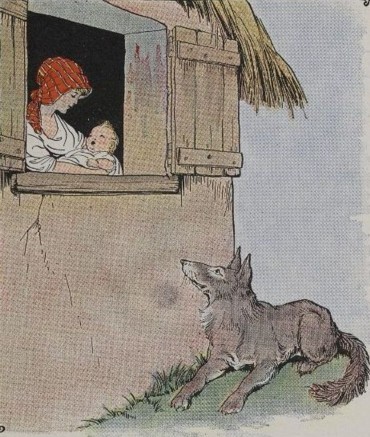PART A_1
Let’s learn vocabulary. Listen and repeat the words and the sentences with your tutor.
PART A_2
| 1. prowl | /proul/ |
| -to move around quietly in a place trying not to be seen or heard, such as an animal does when hunting | |
| The cats prowl the neighborhood at night. | |
| 2. hush | /huhsh/ |
| -used to tell someone to be quiet | |
| Hush! The baby is sleeping now. | |
| 3. fret | /fret/ |
| -to be nervous or worried | |
| Do not fret. He will come back soon. | |
| 4. rock | /rok/ |
| -to (cause someone or something to) move backward and forward or from side to side in a regular way | |
| The mother gently rocked her baby to sleep. | |
| 5. nightfall | /NAHYT-fawl/ |
| -the time in the evening when it becomes dark | |
| The crowd grew bigger at nightfall. |
PART B_1
Let’s read the story. Please read it aloud, and I will check your pronunciation and intonation.
PART B_2
The Mother and the Wolf

Early one morning a hungry Wolf was prowling around a cottage at the edge of a village, when he heard a child crying in the house. Then he heard the Mother’s voice say:
“Hush, child, hush! Stop your crying, or I will give you to the Wolf!”
Surprised but delighted at the prospect of so delicious a meal, the Wolf settled down under an open window, expecting every moment to have the child handed out to him. But though the little one continued to fret, the Wolf waited all day in vain. Then, toward nightfall, he heard the Mother’s voice again as she sat down near the window to sing and rock her baby to sleep.
“There, child, there! The Wolf shall not get you. No, no! Daddy is watching and Daddy will kill him if he should come near!”
Just then the Father came within sight of the home, and the Wolf was barely able to save himself from the Dogs by a clever bit of running.
Do not believe everything you hear.
PART C_1
Let’s answer comprehension questions. Please answer them based on the story.
PART C_2
| 1. | Why was the Wolf delighted when he heard what the mother said? |
| 2. | What was the Wolf doing under the open window? |
| 3. | What did the Mother say to the child toward nightfall? |
PART D_1
Let’s discuss the story. Please answer the questions below and express your opinions.
PART D_2
| 1. | How would you describe the Wolf in the story? |
| 2. | Why do you think the Mother lied to her child? |
| 3. | How can we know if someone is telling the truth or not? |
| 4. | Why is it important not to quickly believe everything that you hear? |
| 5. | Have you had an experience similar to the fable’s lesson? Tell me more about it. |
REVIEW AND FEEDBACK
Now, let us review the things that you learned in this lesson.
ではこのレッスンで学んだことを振り返りましょう。
(Please give a short feedback on how your student did on your class.)
| Grammar 文法 |
Pronunciation 発音 | Vocabulary 単語 |
Comprehension 理解 |
|
|---|---|---|---|---|
 GOOD GOOD |
文法の誤りはほとんどなく、完全な文章で話すことができる | ほとんどの単語をはっきりと正しく発音することができる | 習った表現を適切に使うことができる | 文章を理解し、質問に正しく答えることができる |
 FAIR |
文法の誤りはあるが、完全な文章で話すことができる | 発音の練習が必要な言葉がいくつかある | たまにミスはあるが、習った表現を適切に使うことができる | 文章を完全に理解するのは難しく、質問に正しく答えられないときもある |
 POOR |
文章で話すのは難しく、単語だけで話すことができる | 発音の練習が必要である | 習った単語と表現を少しだけ使うことができる | 文章を理解するのは難しく、質問に答えるのは難しい |
Parts of this lesson material are based on:
An eBook from The Project Gutenberg.
This eBook is for the use of anyone anywhere at no cost and with almost no restrictions whatsoever. You may copy it, give it away or re-use it under the terms of the Project Gutenberg License included with this eBook or online at www.gutenberg.org
An eBook from The Project Gutenberg.
This eBook is for the use of anyone anywhere at no cost and with almost no restrictions whatsoever. You may copy it, give it away or re-use it under the terms of the Project Gutenberg License included with this eBook or online at www.gutenberg.org